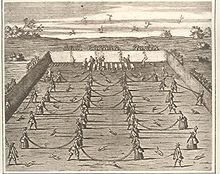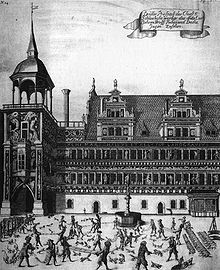Fox bouncing



The fox tossing was from the 16th to 18th century hunting pleasure to the courts of Europe . It consisted of jerking the fox on the ends of a 30 cm wide and 6 to 8 meter long bouncing sheet as soon as it ran over it.
Fox jumping was considered part of the festival culture in court life. It was costly and required a special occasion. Participants were family members and guests of the court of both sexes. The event took place in front of an audience in a fenced-off place in the open air, often in the courtyards of castles or specially created or temporarily separated places in the cities. A thick layer of sand was scattered on the paved ground, and small trees were sometimes planted in it.
After the entry of the hunt , which was framed by hunting music and which was particularly costumed, the players dressed in green for the hunt were set up. It was mostly married or unmarried couples who stood facing each other, holding the loops of the bouncy cloth. They formed several alleys into which the animals previously caught and kept in boxes were to run individually. Occasionally the victims were also costumed for “figured hunting”, for example as harlequin .
The pairs of players hurled the animal, for a change it could also be a hare , an otter , a marten , a badger or a wild cat , as high as possible and often up until it was stunned or its bones hit the ground had broken. It was then the task of the hunters to kill the injured animal. The "amusement" required strength and skill and the participants got confused more or less unintentionally, got out of breath or fell. To a special surprise, “ weak sows ” sometimes escaped from the cage . It was registered as a humorous contribution when these relatively strong animals " make such a rumor under the hoop skirts with the ladies that they cannot be described".
In the age of sensibility and the rococo , games like badminton replaced the fox jumping, now seen as cruelty, as an opportunity for unmarried people to approach informally in noble society .
literature
- Ilse Haseder , Gerhard Stinglwagner : Knaur's large hunting dictionary. Augsburg 2000, ISBN 3-8289-1579-5 , p. 266.
- Franz von Kobell : Wildanger. Sketches from the field of hunting and its history with special consideration for Bavaria. Bavarica Reprint at Süddeutschen Verlag, Munich 1977 (facsimile print of the 1859 edition, Cotta'scher Verlag, Stuttgart. With an afterword by Wilhelm Nerl), pp. 286–289.
- Fritz Röhrig: Das Weidwerk (= second part by Richard B. Hilf, Fritz Röhrig: Forests and pastures in the past and present ). Akademische Verlagsgesellschaft Athenaion, Potsdam undated (1938), p. 171 f.
- Herbert Wotte : Hunting in the Twilight. Of hunters, hunters and poachers. Neues Leben, Berlin 1983, ISBN 3-355-00722-6 , pp. 90-92.
Web links
Individual evidence
- ↑ Röhrig (lit.), p. 171, quoted by Johann Friedrich von Flemming : Der Vollkommene Teutsche Jäger: Anderer Haupt-Part, Darinnen not alone The matter presented in the first part Of the earth, the mountains, herbs, trees, forests, Weather conditions, minerals, wild animals, birds, and other hunting and forestry things, explained with new physical, historical and economic notes and additions and dealt with more completely, but also different new and exquisite hunting and forestry things are taught, Deme was also the well-educated German fisherman. The perfect German hunter. Vol. 2. Leipzig, 1724
- ↑ Kobell (Lit.), p. 286, compared the list of fox jumping with that of the Jeu de Volant